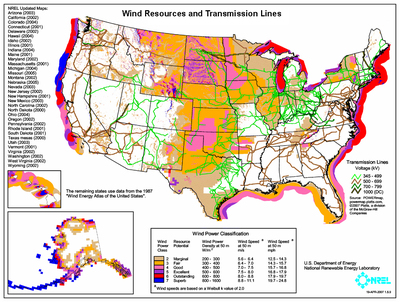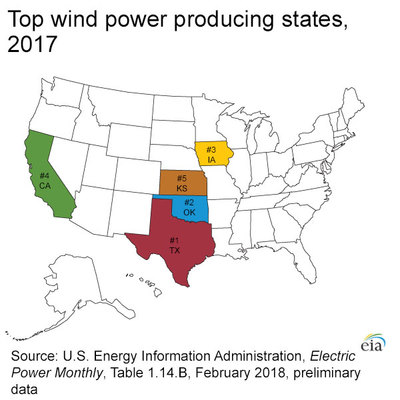Introduction
Resource Location

(click image to enlarge)
Wind is location dependent. A wind power farm must be located where the wind blows. Although there are sufficient locations in the USA where optimal conditions exist for wind power to make a substantial contribution to the national electrical power supply, these locations are usually distant from population centers where power is most in demand and, thus, remote from the electrical grids that furnish power to those populations.
The best conditions in the USA for generating power from wind are found primarily in the northern west and midwest, where wind is more consistent and has greater velocity than in most other locations. See the accompanying map for a review of all areas of the lower 48 states, showing conditions ranging from poor to outstanding.
In addition to onshore locations, there are many offshore areas where the wind is sufficient to be productive as a source of power. Although no offshore wind farms have been built as yet in the USA, this area of development offers great potential for meeting future energy needs.
Top Wind Power States

In 2017 five states produced 66% of the wind electricity generation in the U.S. Those states were Texas, Oklahoma, Iowa, Kansas and California.
Grid Transmission
The U.S. national electrical grid is not extensive in areas that provide the strongest, most consistent wind conditions. To take advantage of wind power, the grid will have to be expanded and extended into these regions with many miles of costly, high voltage transmission lines.
Costs
There are several important variables in considering the cost of a wind power installation. There is a large capital cost in the construction of a wind farm. This is not only reflected in the cost of the turbines themselves, but also includes the cost of extending the complex of electrical grid cables and substations to the wind farm location. Since the windy areas that are optimal for the generation of wind-based electrical power tend to be in remote areas, far from the main body of the national grid, the cost of extending those grid facilities can be very high.
Ongoing power production after construction is complete is considerably more favorable than the initial construction costs. The cost of "fuel" is zero, so the cost of daily generation of power is dependent mostly on other factors, such as the need for additional power sources, environmental effects, and maintenance of the wind turbines. These costs, however, tend to be considerably less, overall, than the upfront capital requirements.
Energy Storage
A major difficulty in utilizing wind as an energy resource is the storage problem. The wind blows intermittently, even in the best of locations. But base energy is needed constantly and consistently. If wind is to become a truly viable power supplier, a low-cost, large-scale method will have to be devised to store that energy for use as needed by the grid.